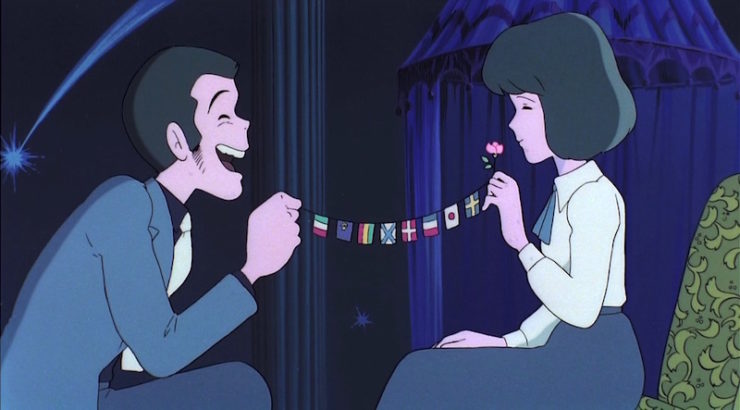Hayao Miyazaki’s 1979 directorial debut, The Castle of Cagliostro, predates the founding of Studio Ghibli. But it lays the groundwork for many of the themes that will pop up throughout the later classics that came from the Studio. Looking back at the film, it’s clear that even right out of the gate, working as a “director for hire,” and using someone else’s characters, Miyazaki still found a way to make a Miyazaki movie.
In revisiting the film, I found that it’s still a fantastic rollercoaster, zipping from rollicking heist to poignant romance to oddly dark melodrama easily, all the while punctuated by goofy, slapstick humor. On paper, this shouldn’t work, but it adds up to a marvelous film that shows many of Miyazaki’s hallmarks already firmly in place. Join me as I discuss the themes and highlights of the film—please be aware of spoilers going forward.
Before Ghibli was a studio, before Nausicäa made Hayao Miyazaki a god among anime fans, and before My Neighbor Totoro made him a god among, well, everyone, he started out as an animator for television. He eventually partnered with fellow animator Isao Takahata to create series including adaptations of Heidi, Anne of Green Gables, and a book called The Incredible Tide that the two re-titled Future Boy Conan. In 1979, Miyazaki was hired to direct his first feature: Lupin III: The Castle of Cagliostro, after directing 14 episodes of the Lupin III television series.
Before I dive into The Castle of Cagliostro, allow me to share some backstory: Lupin III is the grandson of Maurice Leblanc’s gentleman thief Arsène Lupin…kind of. Back in 1967, the manga artist Kazuhiko Katō wrote what he thought would be a short-lived adventure comic about a James Bond-style thief for Weekly Manga Action. He named the character Lupin III, gave him a vague ancestry to tie him to Leblanc’s beloved character, and grudgingly allowed his editor to give him the pen name “Monkey Punch.” After all, this was just going to be a few months, right?
Instead, Lupin III became a huge hit and Katō was stuck with a nom de manga that he hated. Even better, once the character became popular outside of Japan Leblanc’s estate came after him—despite the fact that Leblanc himself used Sherlock Holmes in one of his Lupin stories in “Sherlock Holmes Arrives Too Late,” and had to change the detective’s name to “Herlock Sholmes” (seriously) after a complain from Conan Doyle. After that, Lupin’s name was changed to “Rupan” or “Wolf” when he appeared outside of Japan. After a few years of popularity as a manga star, Lupin was brought to TV in a slightly more family-friendly format. While he’s a violent, lascivious bastard in the manga, Lupin is more of a bumbling cad than a straight-up rapist in the show, and while he still loves stealing, he can also be noble, helping underdogs and using his skills to be more Robin Hood than James Bond. He’s also tied more closely to his gang, Fujiko, Jigen, Goemon, and his nemesis, Inspector Zenigata, than he is in the manga.
Fujiko Mine is primarily a jewel thief, occasionally dating rich men to swindle them, and occasionally working as Lupin’s partner. Lupin is besotted with her, and every once in a while, when things are really tense, she seems to love him almost as much as her diamonds. Just in case you missed the pun, Fujiko is named after Mount Fuji, and her surname is Mine, which means “summit,” and I think it’s pretty obvious why all the mountain imagery is being used here…
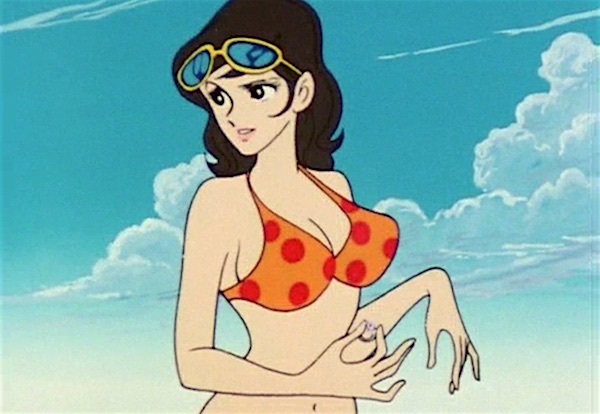
Daisuke Jigen is a crack shot, and visually he seems to be based on James Coburn in The Magnificent Seven (and in turn Jigen seems to be the inspiration for Cowboy Bebop’s Jet Black) and he is completely loyal to Lupin. He haaaates Fujiko.

If Jigen seems to have wandered in from a noir film, Goemon Ishikawa XIII is straight out of a samurai epic. Goemon is the descendant of Ishikawa Goemon, a real-life 16th Century outlaw hero who robbed the elite to help oppressed peasants, and he’s an old school, enrobed, sword-wielding samurai, despite the fact that a typical Lupin plot involves heists in Monaco and cruise ship robberies. He wields an invincible blade, Zantetsuken, that can cut through literally anything.
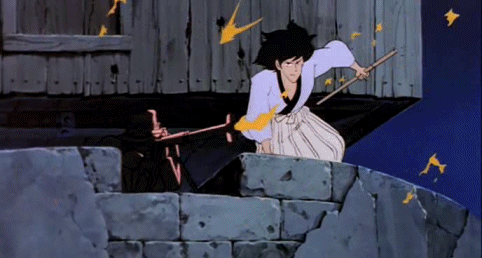
Inspector Zenigata is a Japanese cop who works with Interpol and anyone else necessary to get to Lupin. He’s obsessed with catching the thief. He also serves as a parody of a conventional, hard-working member of Japanese society—and a symbol of the life that Lupin fears most.
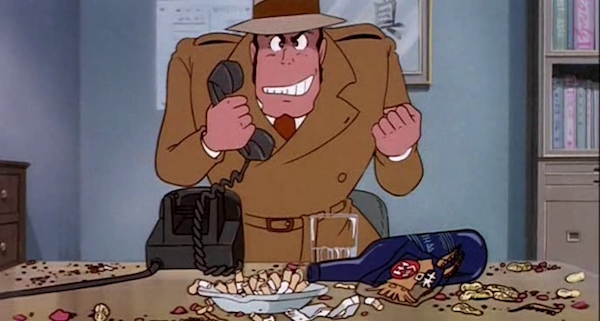
The Castle of Cagliostro was Lupin’s second movie, and it’s a striking departure from his usual capers. My guess is that people heading to the theater to watch a Lupin movie did not expect to find a touching story of lost love buried in all the burglary and fight scenes, and in fact, the film was not successful on its initial release in Japan. As Miyazaki’s reputation grew, however, more people revisited it, and as a result it’s often people’s introduction to Lupin’s world.
The plot begins as a conventional Lupin story, but quickly veers into new territories: Lupin and Jigen rob a Monte Carlo casino, but soon realize that their haul is counterfeit. But who could make bills so perfect that a respected casino couldn’t spot the fakes? Why, the tiny sovereign nation of Cagliostro, currently under the thumb of an evil Count. As luck would have it, Lupin and Jigen literally run into the Count’s bride, Clarisse, as she tries to escape her wedding. After the count re-kidnaps her, Lupin decides that he and Jigen will rescue the girl and expose the counterfeit ring. Goemon and Inspector Zenigata are called in as reinforcements, and Lupin soon discovers that his old flame Fujiko is already working for the Count, deep undercover as the bride’s maid/tutor/prison guard. With all the players in place, the plot zigs and zags through a rescue attempt that gets Lupin thrown into a dungeon, another rescue attempt that gets Lupin shot, and, finally, Clarisse and the Count’s terrifying Gothic wedding, which culminates in yet another rescue attempt, and a final battle inside a clocktower.
Oh, and about that terrifying Gothic wedding? Here’s the Count’s idea of groom attire:
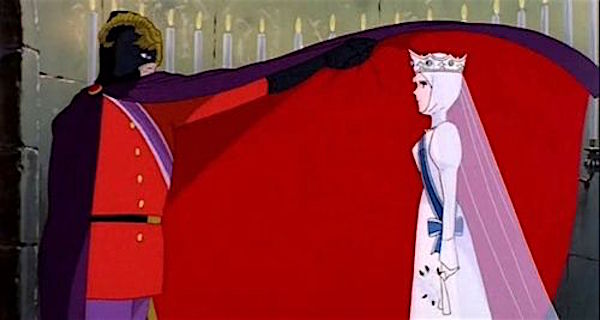
Unlike most Miyazaki films, The Castle of Cagliostro has a true villain—in case you couldn’t tell from that vampiric cloak. The dastardly Count has no ulterior motive, he simply wants the treasure of the Cagliostros. The only possible depth comes when he says that his side of the family are seen as the “dark” Cagliostros, while Clarisse is lucky enough to be one of the “light” and that, while she was raised to be good, her father the Grand Duke ordered the “dark” side of the family to do all the necessary dirty work. (Hence the need for the corpse-stuffed dungeon we see later in the film.) But that’s only a tiny moment of ambiguity, and it’s not nearly enough of a counterweight to “horrible older man who’s forcing a teenage girl to marry him so he can steal her family’s money, while pretending to the press that they’re madly in love and the relationship is totally consensual.”
Is there a counterweight for that? Probably not.
Miyazaki co-wrote the film, and most likely drew on La Justice d’Arsène Lupin (which featured a counterfeiting plot) and The Green-eyed Lady (which featured a treasure at the bottom of a lake) and combined those elements with research he had done for a failed Heidi adaptation to create a whimsical alternative Europe similar to the one he’d later create for Kiki’s Delivery Service. He also included a fun little autogyro to have an excuse to animate flight, which obviously became one of his greatest directorial hallmarks.
Now, as I said, Cagliostro wasn’t considered a hit when it was released, but it’s had a surprising amount of influence. In 1981, a clip from the film was shown at the Disney Studios, where it served as an inspiration to a young John Lasseter, who was committed to the idea that animation should be for everyone, not just small children. (Lasseter also wooed his future wife with clips from the film, which is just sweet.) Nearly twenty years later, Lasseter is the one who stepped in to get Ghibli movies better distribution in the US, ensuring that kids could watch great dubs of Spirited Away and Castle in the Sky, while anime-loving adults could watch the subtitled films and dive into commentary tracks and behind-the-scenes footage.
Lupin’s climactic clock tower confrontation was also, er, lifted? is that fair to say? and dropped into the climactic confrontation between Basil and Ratigan at the end of The Great Mouse Detective, down to Basil and Ratigan wrestling over Olivia Flaversham in turning clockwork…
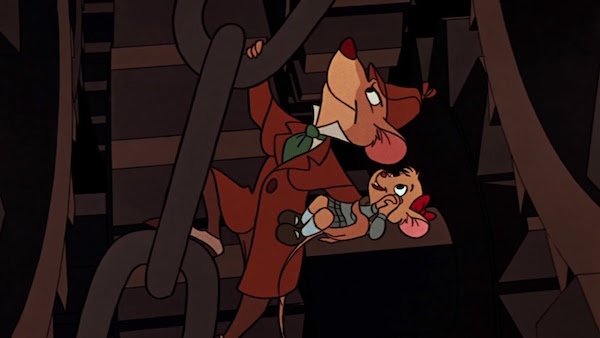
…just as Lupin and the Count wrestle over Clarisse…in turning clockwork.
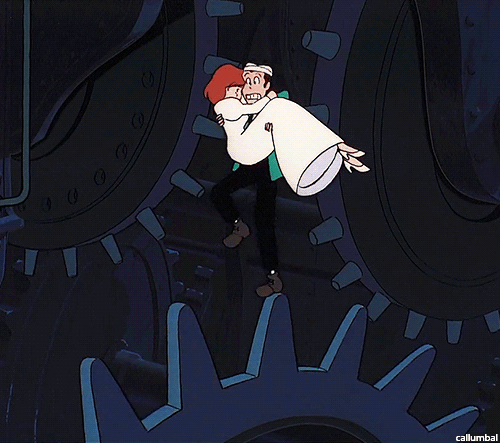
The Castle of Cagliostro has inspired two big rumors over the years. The first is that Steven Spielberg saw a screening of the film in the ’80s, loved it, and based an action scene on the opening car chase. One of the later DVD releases even quote him on the cover calling it “one of the greatest adventure movies of all time.” I couldn’t find anything to confirm it, as, unlike Lasseter, Spielberg has never gone on record as a fan. The other rumor is that when Japan’s Princess Sayako married Yoshiki Kuroda in 2005, she based her wedding dress on Clarisse’s. I also couldn’t find any confirmation on that, although just looking at the dress I don’t see the similarity. Finally, and this might be a stretch, but I choose to believe that Fujiko’s reporter jumpsuit inspired April O’Neill’s fashion.
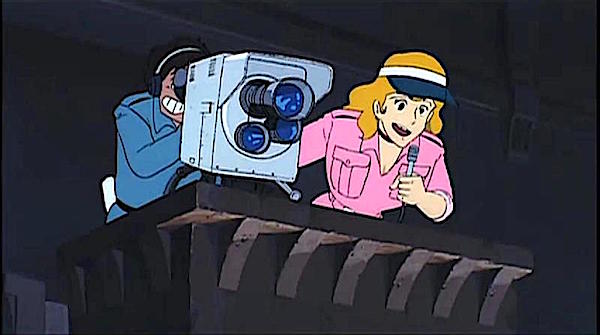
Clarisse and Fujiko
I remembered this as a fun, fluffy movie, but what struck me rewatching it was how Miyazaki managed to smuggle an interesting theme into this heist film. While Miyazaki barely uses Jigen and Goemon (making Lupin more of a lone wolf figure than he is in his other outings) he does make a character choice that would soon become a constant in his filmography: an experienced, mature woman is contrasted with a young ingénue. But not in a competitive way, or even in a standard mentor/mentee type of relationship. Rather, the two women each have their own skills and strengths, and treat each other as respected equals. Here the pair is Fujiko and Clarisse.
The two women embody two very different archetypes of femininity. In the Lupin III manga and anime, Fujiko is a femme fatale/sexpot, trading on her looks and charm to work her way through high society, dating rich men, lifting jewels, and occasionally working as a spy. She’s been hugely popular since her debut, and has starred in a prequel TV series, Lupin III: The Woman Called Fujiko Mine. In Cagliostro, however, Miyazaki dials down her sexuality in favor of making her an action hero, able to embed herself into Cagliostro’s household, only to turn around, ally herself with her usual nemesis Zenigata and pose as a TV reporter to help expose the counterfeiting scheme, all while defending herself from the Count’s goons. Rather than using feminine wiles, she sticks to machine guns and grenades. She also takes a moment to warn Clarisse that Lupin is a playboy—and this is a telling scene. She isn’t jealous of Clarisse, or worried that Lupin will hurt the girl—she just goes slightly out of her way to let Clarisse know what she’s in for if she decides to pursue a romance.
Clarisse, meanwhile, is considered by some to be ground zero for “moe.” Moe began as a nebulous term for anime and manga characters who are young, cute, and almost helpless, who inspire protective love in older characters. Some people interpret it in a sexual way, while others compare it to having an intense crush on a fictional character. (Lately the term has also been used as an alternative to “otaku” to express the intense love a fan can have for a property or character. Yay, language evolution!) In Clarisse’s case, her moe-ness is underlined by the fact that a wild, rakish older man is trying to protect her from being raped by an even older, even more dastardly man, but it’s undercut by the fact that she manages to fight for herself and rescue Lupin on a few occasions. She is portrayed as a young girl, just home from a convent school, and the count keeps her in a tower room fit for a fairy tale:
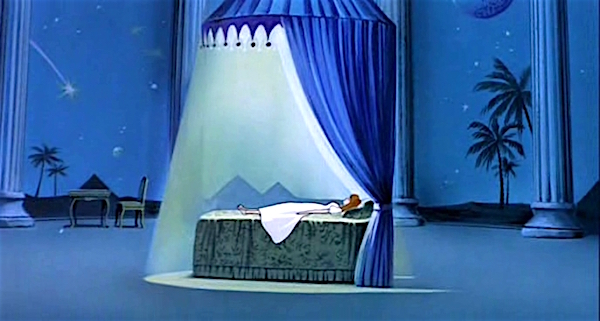
But she’s also bold enough to attempt escape, she stands up to the Count, and she risks her life for Lupin in a way not even Fujiko or Jigen have the guts to do. She lays the groundwork for later Miyazaki heroines like Nausicäa, Kiki, and Chihiro—naïve but plucky and good-hearted. This contrast between the two women leads to a larger theme that makes this film deceptively deep. Lupin is a great anti-hero, right? He risks life and limb to rescue a damsel from a horrific fate? Well, he does, but he also fails. Repeatedly. And when he does succeed, it’s for a very specific reason.
Lupin tries and fails to save Clarisse three separate times: First, during the car chase, he ends up taking the car off the cliff, but uses his handy rope contraption to stop their fall. Until the rope runs out, and they both fall to the beach below, he’s knocked unconscious, and Clarisse is re-kidnapped. Lupin is then rescued by Jigen. The next time he attempts rescue, the Count catches him in Clarisse’s room and drops him into a dungeon. He only survives the dungeon because he teams up with Zenigata. Finally, the Count catches him in Clarisse’s room a second time, and he and Clarisse only escape (momentarily) because Fujiko drops her disguise and lobs a bunch of grenades to cover them. Then the Count and his henchman shoot Lupin. He only survives because Clarisse shields him with her own body…

…which gives Fujiko just enough time to grab him and carry him to the autogyro.
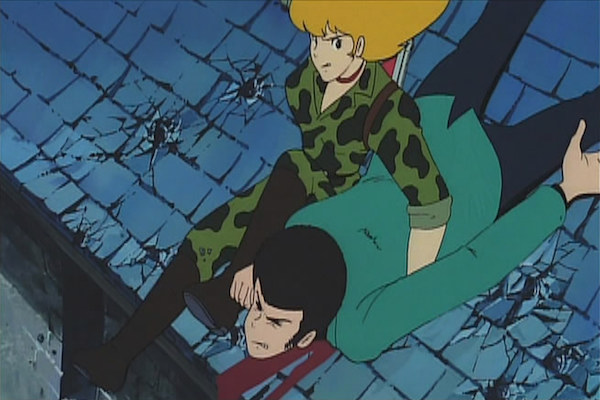
Once they’re away, it’s Clarisse once again who grabs the muzzle of a burning hot machine gun to allow the autogyro to fly out of range.
After this attempt we finally learn why Lupin is so invested: a decade earlier, when Lupin was even more of a foolish punk than he is now….
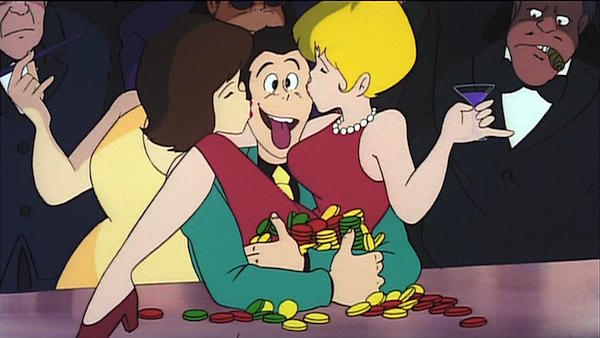
…he tried to trace the origin of the “Goat” bills. He was one of the obsessives he told Jigen about, and he nearly died searching for the secret. So why didn’t he die?
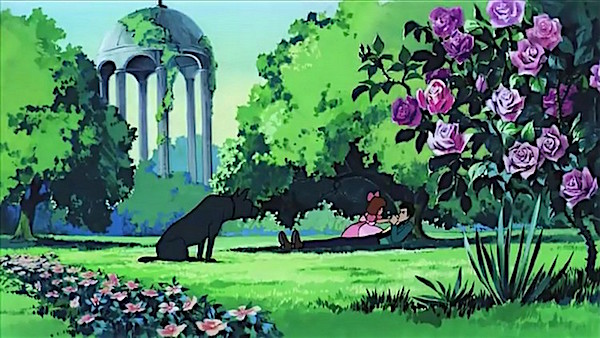
Clarisse.
Tiny, eight-year-old Clarisse found him in her garden after he’d been shot with arrows. Rather than turning him in, she brought him water, and saved his life.
So we learn that his first failure is at the heart of this entire caper, driving him to repay Clarisse’s kindness. There’s another failure here, too, but I’ll get to that in a second.
Only after opening up and telling his friends the story does the tide turn for them. They all team up and concoct a scheme to crash the royal wedding, and finally, with Jigen and Goemon backing him up, and Fujiko and Zenigata acting as reinforcements, do they finally succeed in getting Clarisse away from the Count. Of course, he’s able to track them down so and Lupin can have a classic final showdown… but I think it’s significant that it’s only after Lupin drops what Jigen calls his “sad loner act” that they get anywhere. It’s also significant that even here at the climax, where usually the damsel waits on the sidelines gasping in dismay or yelling encouragement, Clarisse once again risks her life, throwing herself at the Count to try to pull him off the tower.
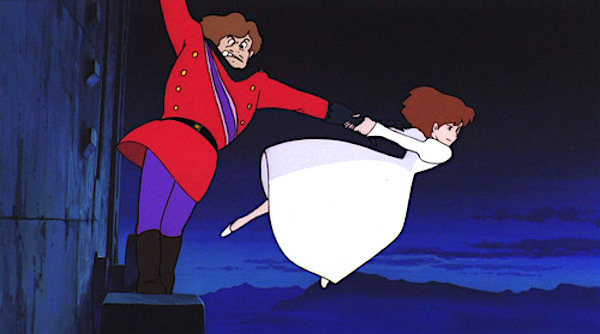
Lupin’s Decision
Now, for that other failure. Young Lupin was presented with true kindness, but rather than taking his near-death experience and Clarisse’s help as a wake-up call, he went right back to his life as a lascivious thief. Now, as a (slightly) more mature man, he has another choice. Clarisse offers to follow him into a life of larceny, and he thinks long and hard before turning her down. It’s a beautiful moment in a fairly silly film, especially since he even restricts himself to giving her a chaste peck on her forehead.
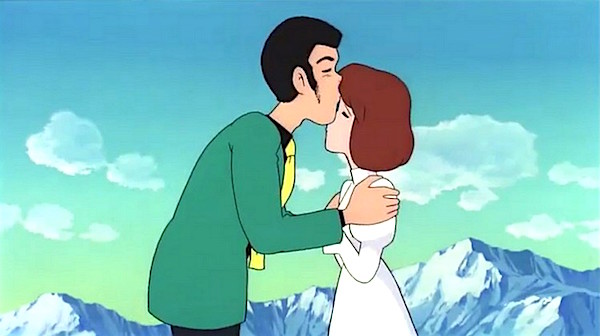
A few moments later, Jigen then offers the other solution: Lupin could stay behind, settle down with Clarisse, start a new life. For Jigen to bring this up is an astonishing departure—this is Lupin’s sharpshooting best friend, literal partner in crime. And Lupin seems to consider it. (I can only imagine the murmurs of shock in the theaters in 1979….) But then Fujiko pulls up on her bike and reveals her loot from Cagliostro: a complete set of counterfeiting plates. Lupin immediately shifts gears, howling after her, and cackling as he realizes Zenigata is in hot pursuit once again. Lupin’s storyline is reset in time for the next television season to begin.
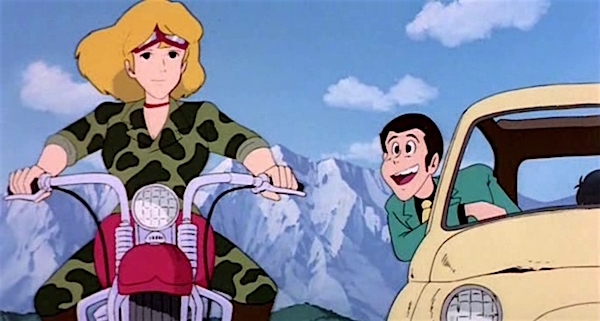
Rejecting Clarisse’s offer was a great moment for Lupin, but you could read the next scene as another failure. Rather than growing up and leaving his ridiculous life for romantic love, he once again turns to crime, and his shallow, on-again-off-again pursuit of Fujiko. Of course this is also true to Lupin’s character, and it’s another way that Miyazaki ducks viewer expectations. When was the last time you watched a movie where a young woman risked her life for a dashing man, only for the two to end up apart? When have you ever seen the older man reject the young ingénue in favor of a more experienced, but also much more independent, lover?
Castle of Cagliostro isn’t just the best big screen foray of a beloved Japanese antihero—it’s also the All About Eve of anime.
Follow along with the Ghibli Rewatch as we delve into Hayao Miyazaki’s oeuvre!
Leah Schnelbach knows she’s not supposed to admire Lupin…but she kinda admires Lupin. Come plan heists with her on Twitter!










